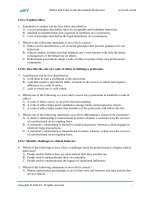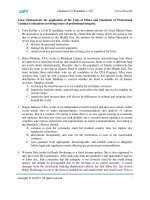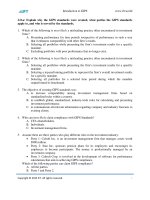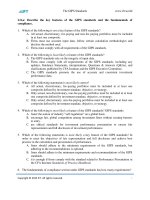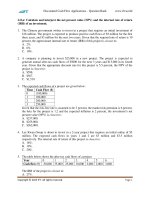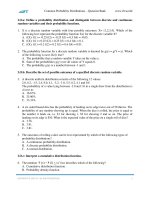CFA 2018 quest bank r54 introduction to asset backed securities q bank
Bạn đang xem bản rút gọn của tài liệu. Xem và tải ngay bản đầy đủ của tài liệu tại đây (316.02 KB, 14 trang )
Introduction to ABS
www.ift.world
LO.a: Explain benefits of securitization for economies and financial markets.
1. Which of the following statements is most likely correct?
Statement 1: Securitization is beneficial for banks because it allows banks to maintain
ownership of their securitized assets.
Statement 2: Securitization is beneficial for banks because it increases the funds available for
banks to lend.
A. Statement 1.
B. Statement 2.
C. Neither of them.
2. Securitization is beneficial for investors because it:
A. provides direct access to mortgages and portfolios of receivables that would be otherwise
unattainable.
B. repackages bank loans into simpler structure.
C. allows them to choose which borrowers to lend to.
3. Which of the following is least likely a benefit of securitization for banks?
A. It transfers credit risk.
B. It increases market capital requirements.
C. It increases funding availability without increasing reserve requirements.
4. Which of the following statements about securitization is least accurate? Due to
securitization:
A. the risk adjusted returns to the ultimate investors can be enhanced.
B. the profitability of banks can be improved.
C. the costs paid by borrowers are effectively higher.
LO.b: Describe securitization, including the parties involved in the process and the roles
they play.
5. In a securitization, the loan servicer is least likely responsible for the:
A. issuance of the asset-backed securities.
B. collection of payments from the borrowers.
C. recovery of underlying assets for delinquent loans.
6. In a securitization, the seller of the collateral is called the:
A. special purpose vehicle (SPV).
B. originator.
C. guarantor.
7. A special purpose vehicle (SPV) most likely:
A. sells accounts receivable.
B. sells asset backed securities.
C. collects payments from borrowers.
Copyright © IFT. All rights reserved.
Page 1
Introduction to ABS
www.ift.world
8. Analyst 1: An SPV makes it possible for the asset-backed securities to have a higher credit
rating than the parent company.
Analyst 2: If bankruptcy occurs, SPV can shield its assets from the parent company’s
creditors.
Which analyst’s statement is most likely correct?
A. Analyst 1.
B. Analyst 2.
C. Both.
LO.c: Describe typical structures of securitizations, including credit tranching and time
tranching.
9. Analyst 1: Credit tranching allows investors to choose between extension risk and
contraction risk.
Analyst 2: Time tranching allows investors to choose between extension risk and contraction
risk.
Which analyst’s statement is most likely correct?
A. Analyst 1.
B. Analyst 2.
C. Neither of them.
10. Credit tranching refers to creating a multi-layered capital structure that has:
A. fully amortizing and partially amortizing tranches.
B. recourse and non-recourse tranches.
C. senior and subordinate tranches.
11. Time tranching helps investors to choose between:
A. extension risk and credit risk.
B. contraction risk and credit risk.
C. extension risk and contraction risk.
LO.d: Describe types and characteristics of residential mortgage loans that are typically
securitized.
12. Frank Smith obtains a recourse mortgage loan for $300,000. One year later, when the
outstanding balance of the mortgage is $290,000, Frank cannot make his mortgage payments
and defaults on the loan. The lender forecloses the loan and sells the house for $250,000.
What amount is the lender entitled to claim from Frank?
A. $0.
B. $40,000.
C. $50,000.
13. Sean obtains a 10 million GBP mortgage loan from Barclays Bank. Two years later, the
principal on the loan is 8 million GBP and Sean defaults on the loan. Barclays Bank
forecloses the loan, sells the property for 6 million GBP, and is entitled to collect the
shortfall, 2 million GBP, from Sean. Sean most likely had a:
Copyright © IFT. All rights reserved.
Page 2
Introduction to ABS
www.ift.world
A. recourse loan.
B. unsecured loan.
C. non-recourse loan.
14. Maria obtains a non-recourse mortgage loan for PKR 8,000,000. Three year later, when the
outstanding balance of the mortgage is PKR 5,000,000, Maria cannot make her mortgage
payments and defaults on the loan. The lender forecloses and sells the house for PKR
3,750,000. What amount is the lender entitled to claim from Maria?
A. PKR 0.
B. PKR 1,250,000.
C. PKR 5,000,000.
15. Ali reviews the status of his home mortgage schedule for the month of December 2013:
Date
01 December
31 December
31 December
Item
Outstanding mortgage loan balance
Total monthly required payment
Interest component of total monthly required payment
Balance (GBP)
700,000
15,000
3,000
On 31 December 2013, Ali makes a payment of GBP 20,000 rather than GBP 15,000. What
will be outstanding mortgage loan balance immediately after the payment is made?
A. GBP 680,000.
B. GBP 683,000.
C. GBP 688,000.
16. Taha is an analyst for Adamjee Insurance that invests in residential mortgage pass-through
securities. Taha reviews the monthly cash flow of one underlying mortgage pool to determine
the cash flow to be passed through to investors:
Total principal paid including prepayment
Scheduled principal to be paid before prepayment
Gross coupon interest paid
Servicing fees
Other fees for guaranteeing the issue
$2,445,000
$445,000
$3,555,000
$145,000
$55,000
Based on Taha’s table, the total cash flow to be passed through to the investors is closest to:
A. $5,800,000.
B. $5,855,000.
C. $6,000,000.
17. Charles Dent obtains a non-recourse loan for $200,000. A year later the principal on the loan
is $180,000 and Charles defaults on the loan. The lender forecloses and sells the house for
$150,000. What amount is the lender entitled to claim from Charles?
A. $0.
B. $30,000.
C. $50,000.
18. A mortgage starts out with a fixed rate and then becomes an adjustable rate after a specified
initial term. The mortgage is most likely a:
Copyright © IFT. All rights reserved.
Page 3
Introduction to ABS
www.ift.world
A. rollover mortgage.
B. renegotiable mortgage.
C. hybrid mortgage.
19. Which of the following statements about convertible mortgages is most accurate?
A. The mortgage rate is initially a fixed rate. At some point, the borrower has the option to
convert into an adjustable rate for the remainder of the mortgage’s life.
B. The mortgage rate is initially an adjustable rate. At some point, the borrower has the
option to convert into a fixed rate for the remainder of the mortgage’s life.
C. The mortgage rate is initially either a fixed rate or an adjustable rate. At some point, the
borrower has the option to convert into a fixed rate or an adjustable rate for the remainder
of the mortgage’s life.
20. Which of the following statements about LTV is least accurate?
A. LTV is the ratio of the property’s purchase price to the amount of the mortgage.
B. Lower the LTV, the more likely the borrower is to default.
C. Lower the LTV, the more protection the lender has for recovering the amount loaned if
the borrower defaults.
LO.e: Describe types and characteristics of residential mortgage-backed securities,
including mortgage pass-through securities and collateralized mortgage obligations, and
explain the cash flows and risks for each type.
21. Analyst 1: Non-agency residential mortgage backed securities consists of a pool of
conforming mortgages as collateral.
Analyst 2: Non-agency residential mortgage backed securities are guaranteed by the
appropriate government sponsored enterprise.
Which analyst’s statement is most likely correct?
A. Analyst 1.
B. Analyst 2.
C. Neither of them.
22. Which of the following is an important consideration of non-agency residential mortgagebacked security (RMBS) as compared to an agency RMBS?
A. Credit risk.
B. Extension risk.
C. Contraction risk.
23. Suppose there are three mortgages with respective balances of $100,000, $200,000, and
$300,000. The mortgage rates are 6%, 7%, and 8% respectively. The WAC is closest to:
A. 6.33.
B. 7.33.
C. 8.
24. Which of the following is least likely an external credit enhancement for an asset backed
security?
Copyright © IFT. All rights reserved.
Page 4
Introduction to ABS
www.ift.world
A. Bond insurance.
B. Letter of credit.
C. Reserve account.
25. Which of the following is not a form of credit enhancement of auto loan-backed securities?
A. Reserve account.
B. Overcollateralization.
C. Under-collateralization.
26. Which of the following statements is correct?
A. Collateral for auto loan-backed securities are non-amortizing loans.
B. Collateral for credit card receivable-backed securities are amortizing loans.
C. Auto loan-backed securities’ principal is typically distributed across different bond
classes each month.
27. An investor who is willing to accept significant prepayment risk if compensated with a
relatively high expected return will most likely invest in:
A. A PAC tranche.
B. A latter-paying tranche in sequential structure.
C. Support tranche.
28. Which of the following is least likely an internal credit enhancement for an asset backed
security?
A. Excess spread.
B. Corporate guarantee.
C. Overcollateralization.
29. Consider a CMO structure with one planned amortization class and one support tranche. The
initial PAC collar was 100-250 PSA. If the actual prepayment speed is 50 PSA, the average
life of the PAC tranche will:
A. contract.
B. extend.
C. remain the same.
30. Which of the following is least likely a feature of a non-agency residential mortgage-backed
security (RMBS)?
A. Overcollateralization.
B. A pool of conforming mortgages as collateral.
C. Senior/subordinated structure.
31. Which of the following statements about the planned amortization class (PAC) structure is
least accurate?
A. Support tranches are exposed to high levels of credit risk.
B. Support tranches provide prepayment protection to the PAC tranches.
C. If prepayments are too low to maintain the PAC schedule, the shortfall is provided by the
support tranche.
Copyright © IFT. All rights reserved.
Page 5
Introduction to ABS
www.ift.world
32. Consider a CMO with three sequential pay tranches A, B, and C. The average lives for the
tranches are 4.6, 10.3, and 15.0 years respectively under a 150 PSA assumption. An investor
concerned about extension risk is most likely to invest in:
A. tranche A.
B. tranche B.
C. tranche C.
33. Consider a CMO structure with one planned amortization class and one support tranche. The
initial PAC collar was 150-250 PSA. If the actual prepayment speed is 100 PSA, the average
life of the PAC tranche will:
A. contract.
B. extend.
C. remain the same.
34. Analyst 1: Although the collateral pays a fixed rate, it is possible to create a CMO with a
floating rate tranche.
Analyst 2: We can create a CMO with a floating rate tranche, only with collateral that pays
floating rate.
Which analyst’s statement is most likely correct?
A. Analyst 1.
B. Analyst 2.
C. Neither of them.
35. Consider a CMO with three sequential pay tranches A, B and C. The average lives for the
tranches are 4.6, 10.3, and 15.0 years respectively under a 150 PSA assumption. An investor
concerned about contraction risk is most likely to invest in:
A. tranche A.
B. tranche B.
C. tranche C.
LO.f: Define prepayment risk and describe the prepayment risk of mortgage-backed
securities.
36. A conditional prepayment rate (CPR) of 6% means that approximately 6% of the outstanding
mortgage pool balance at the beginning of this year will be prepaid:
A. in the current month.
B. by the end of the year.
C. over the life of the mortgages.
37. In the context of mortgage-backed securities, a conditional prepayment rate of 10% means
that approximately 10% of an outstanding mortgage pool balance at the beginning of the year
will be prepaid:
A. by the end of the year.
B. by the end of the month.
C. over the life of the mortgage.
Copyright © IFT. All rights reserved.
Page 6
Introduction to ABS
www.ift.world
38. A PSA assumption of 150 PSA means that:
A. prepayments are slower than the benchmark.
B. prepayments are faster than the benchmark.
C. prepayments are equal to the benchmark.
39. Which of the following statements best describes the relationship between CPR and SMM?
A. SMM deals with the expected prepayment rate while CPR is a measure for the actual
prepayment rate.
B. SMM is a measure of prepayment risk while CPR is a measure of credit risk.
C. CPR is an annualized version of SMM.
40. Which of the following statements about contraction and extension risks is most accurate?
A. Contraction risk increases when interest rates fall and extension risk increases when
interest rates rise.
B. Contraction risk increases when interest rates rise and extension risk increases when
interest rates fall.
C. Contraction risk decreases when interest rate fall and extension risk decreases when
interest rates rise.
41. The principal balance of a pool is $10 million and $100,000 is scheduled to be repaid in a
given month. The SMM is 0.93%. The forecasted prepayment amount for the month is
closest to:
A. $930.
B. $92,070.
C. $93,000.
42. The average life of a MBS is more relevant than the security’s final maturity because it
represents the average time to receipt of:
A. scheduled principal payments.
B. expected prepayments.
C. both expected prepayments and scheduled principal payments.
LO.g: Describe characteristics and risks of commercial mortgage-backed securities.
43. Analyst 1: Commercial mortgage-backed security (CMBS) loans typically have greater call
protection than residential MBS loans because they are usually smaller-dollar sized loans and
hence are not refinanced when interest rates fall.
Analyst 2: Commercial mortgage-backed security (CMBS) loans typically have greater call
protection than residential MBS loans because commercial mortgages may have yield
maintenance charges.
Which analyst’s statement is most likely correct?
A. Analyst 1.
B. Analyst 2.
C. Both.
Copyright © IFT. All rights reserved.
Page 7
Introduction to ABS
www.ift.world
44. In the United States a commercial loan is usually a:
A. recourse loan.
B. non-recourse loan.
C. credit risk-free loan.
45. In a mortgage pass-through security, which of the following has a direct relation with interest
rates?
A. Credit risk.
B. Extension risk.
C. Liquidity risk.
46. Which of the following is least likely a key indicator of potential credit performance of a
commercial mortgage-backed security (CMBS)?
A. Loan-to-value ratio.
B. Debt-to-service-coverage.
C. Value-to-service-coverage.
47. The balloon risk in a CMBS can be best described as a type of:
A. extension risk.
B. contraction risk.
C. interest rate risk.
48. Under the defeasance mechanism of a commercial mortgage, a borrower:
A. is prohibited from making prepayments during a specified period of time.
B. is required to pay a ‘make-whole charge’ penalty if he refinances the loan to get a lower
mortgage rate.
C. provides sufficient funds for the servicer to invest in a portfolio of government securities
that replicates the cash flows that would exist in the absence of prepayments.
LO.h: Describe types and characteristics of non-mortgage asset-backed securities,
including the cash flows and risks of each type.
49. If a credit card receivables asset backed security (ABS) has a lock-out feature:
A. no investors may sell the ABS for a certain period of time.
B. no payments are made to the ABS investor for a certain period of time.
C. no principal payments are made to the ABS investor for a certain period of time.
50. In a credit card receivable asset backed securities (ABS) cash flows paid to security holders
is based on:
A. finance charges collected and fees.
B. finance charges collected only.
C. fees only.
51. Jane Smith is seeking to purchase an ABS backed by automobile loans. However, Jane is
extremely concerned about prepayment risk. Which of the following factors should least
concern Jane?
Copyright © IFT. All rights reserved.
Page 8
Introduction to ABS
www.ift.world
A. Insurance payoffs.
B. Loan refinancing.
C. Trade-ins.
LO.i: Describe collateralized debt obligations, including their cash flows and risks.
52. In an arbitrage CDO structure, is the collateral manager required to actively manage the debt
obligations?
A. Yes.
B. No.
C. It depends on what type of CDO structure we are creating.
53. Interest rate swaps are required in CDOs because:
A. cash flows are mismatched.
B. the subordinated tranche investors have credit risk.
C. the equity tranche investors have credit risk.
54. A CDO be best described as:
A. a security backed by a specific type of debt obligation.
B. a security backed by debt and equity instruments.
C. a security backed by a pool of one or more debt obligations.
Copyright © IFT. All rights reserved.
Page 9
Introduction to ABS
www.ift.world
Solutions
1. B is correct. Securitization allows banks to remove assets from their balance sheet, therefore
increasing the pool of available capital that can be loaned out.
2. A is correct. Securitization is beneficial for investors because it provides direct access to
mortgages and portfolios of receivables that would be otherwise unattainable.
3. B is correct. The benefits of securitization include transfer of credit risk, increased funding
availability without increasing reserve requirements, and automatically decreased market
capital requirements.
4. C is correct. Because of securitization, the costs paid by borrowers can be effectively
reduced.
5. A is correct. In a securitization, the special purpose vehicle (SPV) is responsible for the
issuance of the asset backed securities.
6. B is correct. In a securitization, the seller of the collateral is called the originator.
7. B is correct. Special purpose vehicles (SPV) sell asset backed securities. The originator sells
assets (receivables) to the SPV for cash. The servicer is responsible for the collection of
payments from the borrowers.
8. C is correct. Both statements are correct.
9. B is correct. Time tranching or prepayment tranching allows investors to choose between
extension risk and contraction risk.
10. C is correct. Credit tranching refers to creating a multi-layered capital structure that has
senior and subordinate tranches.
11. C is correct. Time tranching helps investors in choosing between extension risk and
contraction risk.
12. B is correct. In a recourse loan, the lender is entitled to claim the shortfall between the
mortgage balance outstanding and the proceeds received from the sale of the property. i.e.
290,000 – 250,000 = 40,000.
13. A is correct. Barclays Bank has a claim against Sean for the shortfall between the amount of
the mortgage balance outstanding and the proceeds received from the sale of the property.
This indicates that the mortgage loan is a recourse loan. If Sean had a non-recourse loan, the
bank would have only been entitled to the proceeds from the sale of the underlying property.
Copyright © IFT. All rights reserved.
Page 10
Introduction to ABS
www.ift.world
14. A is correct. For a non-recourse loan, the bank can only look to the underlying property to
recover the outstanding mortgage balance and has no further claim against the borrower. The
bank is simply entitled to foreclose on the home and sell it.
15. B is correct. The difference between the GBP 15,000 monthly mortgage payment and the
GBP 3,000 portion of the payment that represents interest equals GBP 12,000, which is the
amount of the total required payment applied to reduce the outstanding mortgage balance. In
addition, a payment made in excess of the monthly mortgage payment is called a
prepayment. The prepayment of GBP 5,000 is a partial pay down of the mortgage balance.
The outstanding mortgage balance after the GBP 20,000 payment is the mortgage balance of
GBP 700,000 – GBP 12,000 – GBP 5,000 = $683,000.
16. A is correct. The total cash flow to be received by the investors is as follows:
Total principal + gross coupon interest - less servicing and other fees = $2,445,000 +
$3,555,000 – $145,000 – $55,000 = $5,800,000.
17. A is correct. In a non-recourse loan, the lender can only look to the underlying property to
recover the outstanding mortgage balance and has no further claim against the borrower.
18. C is correct. When the mortgage starts out with a fixed rate and then becomes an adjustable
rate after a specified initial term, the mortgage is referred to as a hybrid mortgage. If the
mortgage rate is fixed for some initial period and is then adjusted to a new fixed rate, the
mortgage is referred to as a rollover or renegotiable mortgage.
19. C is correct. In a convertible mortgage, the mortgage rate is initially either a fixed rate or an
adjustable rate. At some point, the borrower has the option to convert into a fixed rate or an
adjustable rate for the remainder of the mortgage’s life.
20. B is correct. Lower the LTV, the less likely the borrower is to default.
21. C is correct. Agency residential mortgage backed securities consists of a pool of conforming
mortgages as collateral. Agency residential mortgage backed securities are guaranteed by the
appropriate government sponsored enterprise.
22. A is correct. Credit risk is an important consideration of non-agency residential mortgagebacked security (RMBS) as compared to an agency RMBS.
23. B is correct. Weighted average coupon =
= 7.33.
24. C is correct. A reserve account is an internal credit enhancement.
25. C is correct. Under-collateralization is not a form of credit enhancement of auto loan-backed
securities.
Copyright © IFT. All rights reserved.
Page 11
Introduction to ABS
www.ift.world
26. C is correct. The collateral for credit card receivable-backed securities are non-amortizing
loans, whereas the collateral for auto loan-backed securities are amortizing loans. Auto loanbacked securities’ principal is typically distributed across different bond classes each month.
27. C is correct. The prepayment risk is first absorbed by the support tranche before affecting the
PAC tranche. For this reason, a support tranche has high prepayment risk and therefore a
higher expected rate of return.
28. B is correct. Corporate guarantee is an external credit enhancement.
29. B is correct. If the actual PSA rate is slower than the lower collar of the PAC, the average life
of the PAC tranche will extend.
30. B is correct. Conforming mortgages are used as collateral for agency mortgage pass-through
securities. Non-agency RMBS are credit enhanced, either internally or externally, to attract
investors. The most common forms of internal credit enhancements are senior/subordinated
structures and overcollateralization.
31. A is correct. Support tranches are exposed to high levels of prepayment risk not credit risk.
32. A is correct. In this structure tranches B and C provide protection against extension risk to
Tranche A.
33. B is correct. If the actual PSA rate is lower than the lower collar of the PAC, the average life
of the PAC tranche will extend.
34. A is correct. Although the collateral pays a fixed rate, it is possible to create a CMO with a
floating rate tranche. This is done by constructing a floater and an inverse floater
combination.
35. C is correct. In this structure tranches A and B provide protection against contraction risk to
Tranche C.
36. B is correct. The CPR is an annual prepayment rate.
37. A is correct. A conditional prepayment rate (CPR) is an annualized rate which indicates the
percentage of the mortgage balance at the beginning of the year which is expected to be
prepaid by the end of the year.
38. B is correct. The benchmark is said to be 100 PSA, anything over 100 PSA means that
prepayments are assumed to be faster than the benchmark.
39. C is correct. CPR is an annualized version of SMM. The other statements are incorrect.
Copyright © IFT. All rights reserved.
Page 12
Introduction to ABS
www.ift.world
40. A is correct. Contraction risk increases when interest rates fall and extension risk increases
when interest rates rise.
41. B is correct. Prepayment = SMM * (Beginning balance – Scheduled principal repayment) =
0.93% * (10,000,000 – 100,000) = 92,070.
42. C is correct. The average life of a MBS is more relevant than the security’s final maturity
because it represents the average time to receipt of both expected prepayments and scheduled
principal payments.
43. B is correct. The call protection in CMBS at the loan level is achieved through four
mechanisms: prepayment lockouts, prepayment penalty points, yield maintenance charges,
and defeasance. CMBS are not typically smaller sized loans.
44. B is correct. In the United States and other countries, commercial mortgage loans are usually
non-recourse loans.
45. B is correct. When interest rate increases, extension risk increases because there will be
fewer prepayments. This shows that interest rate has a direct relation with extension risk.
46. C is correct. Two measures that have been found to be key indicators of potential credit
performance of a commercial mortgage-backed security (CMBS) are the loan-to-value ratio
(LTV), and the debt-to-service-coverage (DSC) ratio.
47. A is correct. Balloon risk refers to the risk that a borrower will not be able to make the
balloon payment when due. Since the term of the loan will be extended by the lender during
the workout period, balloon risk is a type of extension risk.
48. C is correct. Under the defeasance mechanism of a commercial mortgage a borrower
provides sufficient funds for the servicer to invest in a portfolio of government securities that
replicates the cash flows that would exist in the absence of prepayments.
49. C is correct. If a credit card receivables asset backed security (ABS) has a lock-out feature no
principal payments are made to the investor, instead the principal repayments are reinvested
in new receivables.
50. A is correct. The cash flow is paid from finance charges collected and fees.
51. B is correct. Refinancing of automobile loans is a low probability event due to the short
maturity of the loans.
52. A is correct. In an arbitrage CDO, a CDO manager buys and sells debt obligations in order to
pay off the holders of the bond classes and to generate an attractive return for the equity
tranche and for the manager.
Copyright © IFT. All rights reserved.
Page 13
Introduction to ABS
www.ift.world
53. A is correct. Interest rate swaps are required because the cash inflows from floating or fixed
rate assets are mismatched with the cash outflows to floating rate tranches.
54. C is correct. A CDO is a security backed by a diversified pool of one or more debt
obligations.
Copyright © IFT. All rights reserved.
Page 14
